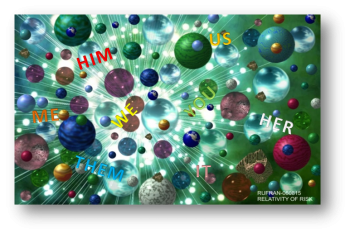Risk relativity

For a thief, a good security system is a threat. To a security guard, that same system is an opportunity to lessen the risk of robbery and to increase the chance of catching the thieves.
A person’s perspective depends on which side of the fence he is sitting on. With that in mind, a risk can be a threat or an opportunity. Your business sees a threat and your competitor sees an opportunity. It is as simple as that.
Each individual player within the risk universe will see things a bit differently compared to the next person, with some people interpreting things in exactly the opposite fashion. In each case, the person can see only one attribute.
The simplistic objective point of view is that risk is either a threat or an opportunity, depending on the observer’s orientation to the goal.If one sits on his most important goal and look at the potential risk, the resultant or prevailing consequence describes whether it is a threat or an opportunity.
Anyone who contemplate risk should consider that threats also bring with it opportunities and opportunities also brings threats.These are underlining characteristics that all risk practitioners have to remind themselves always. Have you ever heard the saying, "every cloud has a silver lining"?
We can readily conclude that this tested adage found to be true for many centuries is actually a risk-based management concept.

Figure 1 - Risk Universe
Now, if we could take an even more macroscopic view of the risk universe as an independent observer, we would be able to see risk from more than one perspective and gain a level of understanding that most of us never thought possible before - that risk is both a threat and an opportunity.
We can see both possibilities existing simultaneously. When we have no stake in the game¸ we can relate to both parties’ positions.
Risk is not absolute, but relative.If one thinks about it a little deeper, the concept of risk becomes more evident. The risks of threat and opportunity are two sides of the same event. Obviously, events and objectives go hand in hand, as your objectives will depend on how you interpret events.
Using the set theory and imagining risk using a Venn diagram, one might imagine the concept of uncertainty as a big system where risk resides.
Given a singular risk that revolves around a given objective, considering a vast system called uncertainty, the probability of that risk is impossible to measure.
We can calculate the probability of an identified and specific risk because we can appreciate the uncertainty boundary (or field) where the risk lies.
The finite boundary (a small piece of the whole uncertainty system) relevant to the objective is the only useful element in appreciating that risk, a piece of mathematical uncertainty that has practical use. It is the kind of uncertainty with more reliable probabilistic basis.We've all heard that beauty is in the eye of the beholder, meaning that the perception of beauty is subjective. Similarly, perception of risk is subjective because it is relative. It depends on how one interprets a situation. Duality in this sense points to two kinds of perceptions rather than two intrinsic attributes in one.

Many writers in the last few centuries have touched on the concepts of relativity and subjectivity when talking about how a person sees their surroundings.
Below, are some phrases about this, but it is up to you to make the comparison between these poetic relationships and people’s perceptions of risk. I thought it would be fun to inject risk’s syllogism and indirect association within some memorable quotes.
In 1588, the English dramatist John Lyly, in his Euphues and His England, wrote: "...as neere is Fancie to Beautie [RISK], as the pricke to the Rose, as the stalke to the rynde, as the earth to the roote."
Shakespeare expressed a similar sentiment in Love's Labours Lost, 1598. "Good Lord Boyet, my beauty [RISK], though but mean, / Needs not the painted flourish of your praise: / Beauty [RISK] is bought by judgment of the eye, / Not utter'd by base sale of chapmen's tongues."
Benjamin Franklin, in Poor Richard's Almanack, 1741, wrote, "Beauty [RISK], like supreme dominion is but supported by opinion."David Hume's Essays, Moral and Political, 1742, includes the statement that "Beauty [RISK] in things exists merely in the mind which contemplates them."
The person who is widely credited with coining the saying in its current form is Margaret Wolfe Hungerford (née Hamilton), who wrote many books, often under the pseudonym of 'The Duchess'.
In Molly Bawn (1878), readers will find the following line: "Beauty [RISK] is in the eye of the beholder (The Phrase Finder, 2015)."Oftentimes, the discussion on subjects such as risk has a tendency to turn into something more esoteric.
When that happens, as a Risk Manager, we should appreciate the brilliance of some people’s individual premises, suppositions, commentaries, and conclusions, for they can add value and substance to what we already know.
Source: Frago, R. (2015). Risk-based Management in the World of Threats and Opportunities: A Project Controls Perspective. ISBN 978-0-9947608-0-7 (Canada).Section 1.2
Rufran C. Frago – Author (14-Oct-16)
Related sites:
- E-Touch Up
- My Oil Pro
- Risk-based Management and Services Inc. Facebook
- E-Touch Up (Facebook)
- Your World, Our Risk Universe: Wordpress
- LinkedIn Professional Website
Related articles authored by Rufran Frago:
- Phantom Schedules
- Man is the Center of the Risk Universe
- Project Schedule Baseline Top 10 Prerequisites
- Setting Critical Path
- Primer to Good Schedule Integration
- Project Schedule: P50, Anyone?
- Schedule Baseline Dilemma Part 1
- Mega-Projects Schedule Management and Integration
- Scaffolding Hours: What are they? Part 1
- Your World, Our Risk Universe
 Printer-friendly version
Printer-friendly version- Login or register to post comments
 Send to friend
Send to friend




